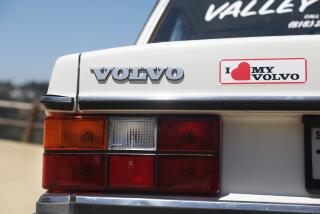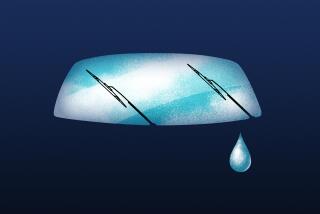Grin or Grimace
In the history of four wheels and an engine, few automobiles have landed with such a sopping wet, suicide-on-the-sidewalk report as the Pontiac Aztek. From the moment the curtain drew back at the 2000 auto show in Detroit, people hated it with a dark, unappeasable glee. One wag said the Aztek looked like Montezuma’s Revenge feels. So much for nuance.
After four years and slightly more than 100,000 copies, GM quietly sacked the Aztek (2005 is its last model year). And it was then that I started feeling sorry for it. I saw one at last year’s Los Angeles auto show. While the GM pavilion frothed with lights and rotating platforms and gamine spokesmodels demonstrating fold-down seats, the Aztek sat in a dim corner near the exit, unlovely and unloved, the lumpen shame of the family. No wonder I felt a kinship.
What was this vehicle’s crime? After all, the Aztek is exactly the kind of sport-utility/minivan that people were telling GM they wanted. It had all-wheel drive, room for the family and scads of convenience features: a built-in cooler and cup holders big enough to swim in. It could even be had with an optional tent attachment for camping--the Aztek tended to keep the bears away.
The Aztek’s troubles lay not down deep but at the surface. It violated the first principle of anthropomorphic car design--that cars should look like us.
Specifically, it had four eyes and two sets of nostrils. The Aztek’s glittering headlights and running-light assemblies were stacked on the corners and the wide grille was topped with a slit intake under the leading edge of the hood. The effect was of two faces split at the nose and sewn together, a monstrous yuppie Caliban. It’s not simply that people didn’t care for the Aztek styling. It riled them in some primitive way. To scan the message boards about the car now is to hear dogs barking madly at alien invaders.
We read cars like we read faces. Researchers at Vanderbilt University have discovered that car experts use the same region of the brain’s right hemisphere to recognize cars as they use to identify faces. It seems we register the physiognomy of both by holistically processing the features--eyes and headlights, bumpers and mouths--and summing up all the variations to compose recognition.
The compound-eyed Aztek foils this rote processing, as does the Fiat Multipla, the justly reviled utility wagon sold in Europe that carries an extra set of eyes at the base of its windshield. Yet neither the Multipla nor the Aztek can hold an uncomely candle to the 1957 Aurora. Built by Father Alfred Juliano, a parish priest in New York who was obsessed with automotive safety, the Aurora has been dubbed the “world’s ugliest car”--I cannot say who dubbed it so, but I’m not about to gainsay his or her judgment.
The Aurora, which was salvaged and restored by a midday-sun Englishman named Andy Saunders, has a gaping, impact-absorbing aperture in front that looks like the car feeds on krill. Thar she blows, indeed.
Remember the Honda commercial last year that paired its products on a split-screen with people’s faces and heads? The temptation to anthropomorphize is almost irresistible. Part of the reason, surely, is that we have such intimate relationships with our automobiles; we interpose a face, a being-ness on them so that we can relate to them better. We give them a gender and names. My red MGA answers to the name Lucy.
Meanwhile, automotive technology, intentionally or not, has made cars look more like us. Until the 1940s, production automobiles had vertical grilles, shiny chrome prows cleaving the air, more helmet visors than faces. But by the late ‘40s, as cars got lower and bodywork more streamlined, grilles became increasingly mouthlike and horizontal, a wide rictus of bared metal teeth.
And so by the late 1950s you have a car like the Austin-Healey Bugeye Sprite, a smiling asphalt nymph that looks like it will speak a spell at any moment.
Even the classic VW Beetle--air-cooled and rear-engined, thus requiring no grille up front--has a full chrome bumper slightly turned up at the ends, and those perpetually astonished eyes, a charmed countenance that I’m pretty sure its Nazi designers didn’t intend.
Headlights are windows to the soul: the fierce Kabuki gaze of a Mitsubishi 3000GT; the menacing, heavy-lidded stare of a late-model BMW, its irises glowing; the chop-licking leer of a Corvette. Would you let any of them baby-sit your kids?
Small cars are often hot-dip galvanized in a kind of smiling whimsy by their designers, cars like the beloved BMW Mini, the Renault Twingo, the Peugeot 107, the Suzuki Aerio, the Mercedes-Benz Smart. All of these are cars designed for the share-and-share-alike confines of city traffic. The friendlier the better.
It’s been said that by the time we turn 40 we get the face we deserve. The beauty of automobiles is that it’s never too late to trade in. Perhaps you want to replace the ogre-like visage of the Hummer H2 for something with a sweeter disposition. Perhaps the world will smile back.






